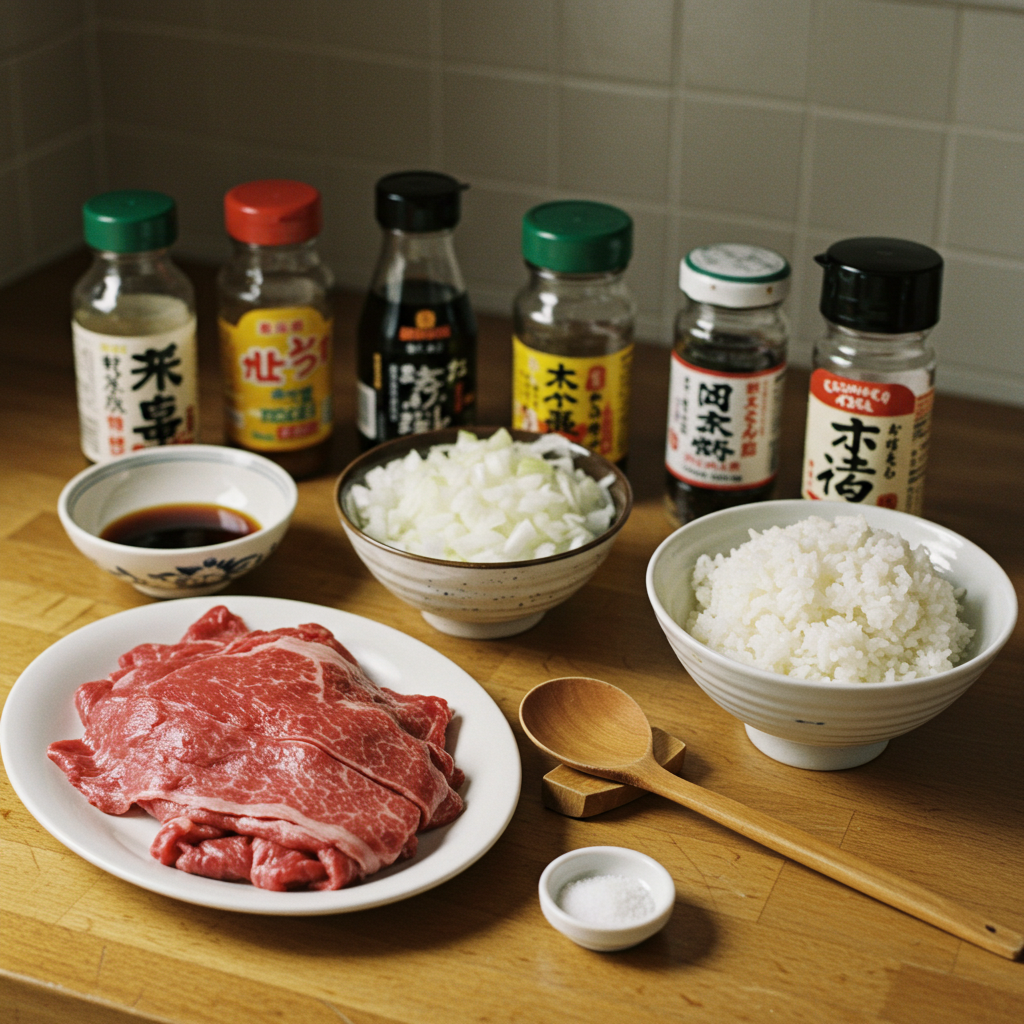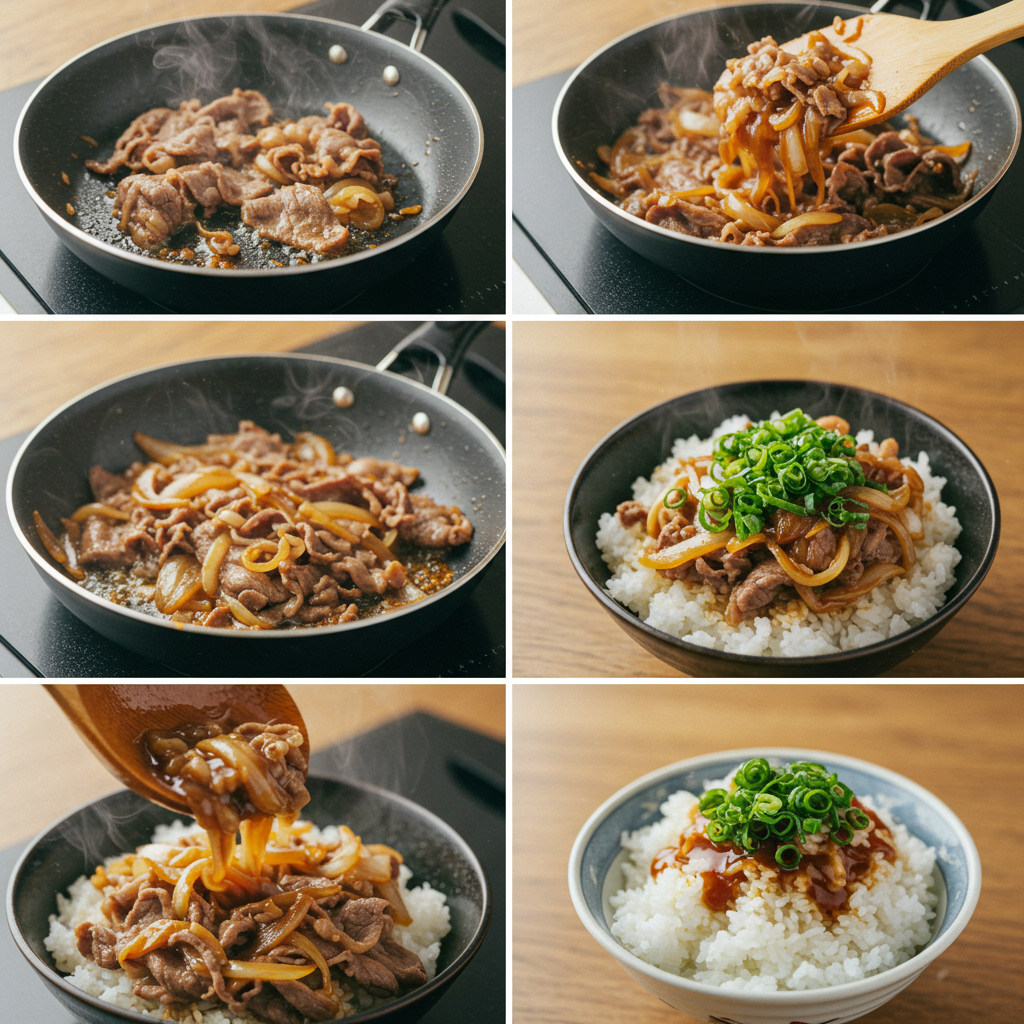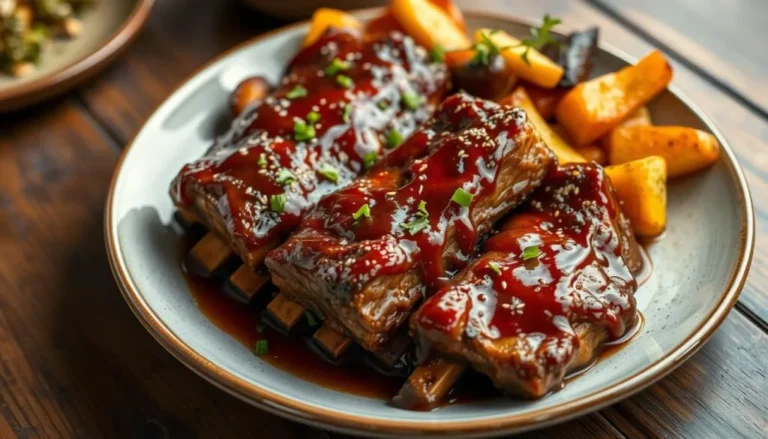Authentic Yoshinoya Beef Bowl Recipe
Table of Contents
Have You Ever Wondered How to Make Restaurant-Quality Japanese Beef Bowls Without Special Ingredients?
What if I told you that the secret to making Yoshinoya’s famous beef bowl has been hiding in your local grocery store all along? That’s right – you can create that same delicious taste of thinly sliced beef, sweet onions, and savory sauce over fluffy rice right in your own kitchen!
The Yoshinoya beef bowl recipe (or “gyudon” as it’s called in Japan) has been a beloved fast food staple for over 120 years. This simple yet flavorful dish combines tender beef and onions simmered in a sweet-savory sauce, all served over a bowl of steaming rice. It’s the ultimate comfort food that millions of people enjoy every day, and now you can make it at home with ingredients you can find at any grocery store!
What Makes This Recipe Special
This Yoshinoya beef bowl recipe isn’t just any beef bowl – it’s carefully crafted to match the flavors of Japan’s most famous beef bowl chain. Here’s why this recipe is worth trying:
- Quick to Make: Only takes about 30 minutes from start to finish
- Easy to Follow: Simple steps that even beginners can master
- Affordable: Uses basic ingredients that cost much less than takeout
- Authentic Taste: Captures the same flavors as the restaurant version
- Flexible: Can be adjusted to suit your taste preferences
This Japanese rice bowl recipe is perfect for busy weeknights when you want something tasty but don’t have hours to spend in the kitchen. With just a few ingredients and simple steps, you can enjoy a restaurant-quality meal at home.
Essential Ingredients for Yoshinoya Beef Bowl

To make an authentic Yoshinoya beef bowl recipe, you’ll need these key ingredients:
For the Rice:
- Japanese short-grain rice (2 cups): This sticky rice is the perfect base for soaking up the savory sauce. Brands like Nishiki or Calrose work well.
- Water (2½ cups): For cooking the rice properly
For the Beef and Sauce:
- Thinly sliced beef (1 pound): This is the star of the show! Ribeye or chuck sliced paper-thin works best.
- Onions (2 medium): Adds sweetness and texture to the dish
- Dashi stock (½ cup): This Japanese soup stock adds depth of flavor
- Soy sauce (¼ cup): Provides saltiness and rich color
- Mirin (3 tablespoons): A sweet Japanese cooking wine that balances the savory flavors
- Sake (2 tablespoons): Japanese rice wine that adds complexity
- Sugar (2 tablespoons): Helps create that signature sweet-savory balance
- Fresh ginger (1 tablespoon, grated): Adds a subtle kick and freshness
For Garnish:
- Green onions: Adds color, freshness, and a mild onion flavor
- Pickled ginger: Provides a tangy contrast to the rich beef
- Toasted sesame seeds: For a nutty flavor and extra texture
Why These Ingredients Matter:
The magic of this Japanese beef bowl recipe comes from the balance of flavors. The dashi creates a savory base, while mirin and sugar add sweetness to balance the salty soy sauce. The sake adds depth, and the ginger provides a subtle zing that cuts through the richness.
Ingredient Substitutions:
Don’t worry if you can’t find every traditional ingredient! Here are some easy substitutions:
- No dashi? Use beef broth with a splash of fish sauce or soy sauce
- No mirin? Mix 3 tablespoons white wine with 1 tablespoon sugar
- No sake? Use dry sherry or more dashi stock
- Can’t find thinly sliced beef? Ask your butcher to slice it thin, or partially freeze beef and slice it yourself
Step-by-Step Instructions for Yoshinoya Beef Bowl

Let’s break down the process of making this delicious Yoshinoya beef bowl recipe into simple steps:
1. Prepare the Rice
- Rinse 2 cups Japanese rice in cold water 3-4 times until water runs clear
- Place rinsed rice in a rice cooker or pot with 2½ cups water
- If using a rice cooker: Press start and let it do its thing
- If using a pot: Bring to a boil, reduce heat to low, cover, and simmer for 15 minutes
- After cooking, let rice rest covered for 10 minutes before fluffing
Cooking Tip: Don’t lift the lid while rice is cooking – this lets steam escape and can make your rice unevenly cooked!
2. Prepare the Ingredients
- Slice 2 medium onions into thin half-moons
- Grate 1 tablespoon fresh ginger
- Slice green onions thinly for garnish
- Make sure beef slices are separated (if frozen, thaw first)
Prep Tip: Getting everything ready before you start cooking makes the process much smoother and faster.
3. Make the Sauce
- In a bowl, mix ½ cup dashi stock, ¼ cup soy sauce, 3 tablespoons mirin, 2 tablespoons sake, and 2 tablespoons sugar
- Stir until sugar completely dissolves
- Add the grated ginger and mix well
Flavor Tip: Take a small taste of your sauce – it should be balanced between sweet and salty. Add a little more sugar if it’s too salty. Add a bit more soy sauce if it’s too sweet.
4. Cook the Onions
- Heat a large pan over medium heat
- Add 2 tablespoons cooking oil
- Add sliced onions to the pan
- Cook for 5-7 minutes until soft and translucent, but not browned
Cooking Tip: Don’t rush this step! Properly cooked onions add natural sweetness and texture to your Japanese beef bowl recipe.
5. Add the Sauce and Simmer
- Pour the prepared sauce over the softened onions
- Bring to a gentle simmer
- Let it bubble gently for about 2-3 minutes to allow flavors to mix together
Simmering Tip: Keep the heat medium-low to prevent boiling too hard, which can make the meat tough.
6. Cook the Beef
- To the simmering sauce, add the thinly sliced meat.
- Separate the beef slices as you add them to ensure even cooking
- Cook for 3-5 minutes until the beef just changes color from pink to light brown
Beef Cooking Tip: Don’t overcook the beef! It continues cooking in the hot sauce even after you turn off the heat. Overcooked beef becomes tough and chewy.
7. Final Simmer
- Once beef has changed color, reduce heat to low
- Simmer for 1-2 minutes more to allow flavors to combine
- Turn off heat and let sit for 1 minute
Flavor Tip: This short rest period allows the beef to absorb more flavor from the sauce.
Assembly: Building Your Yoshinoya Beef Bowl
Now comes the fun part – putting together your Yoshinoya beef bowl recipe!
Basic Assembly:
- Scoop freshly cooked rice into a bowl, filling it about halfway
- Use a slotted spoon to place beef and onions on top of the rice
- Spoon some of the sauce over the beef and rice
- Sprinkle sliced green onions on top
- Add a sprinkle of toasted sesame seeds
- Place a small pile of pickled ginger on the side if you like
Presentation Tips:
- Sauce Amount: Add enough sauce to flavor the rice, but not so much that it becomes soggy
- Bowl Choice: Use a wide bowl with high sides if you have one – this is the traditional way to serve it
- Color Balance: The green onions and pink pickled ginger add nice color contrast to the brown beef and white rice
- Portion Size: For an authentic experience, use about 60% rice and 40% beef topping
Extra Topping Ideas:
- Soft-boiled egg: Cut in half and place on top for extra richness
- Shichimi togarashi: Japanese seven-spice blend for those who like a little heat
- Thin strips of nori seaweed: Adds umami flavor and texture
- Extra sauce: Serve a little extra sauce on the side for those who like more
Storage and Make-Ahead Tips
Your Japanese beef bowl recipe components can be made ahead and stored for later!
Storing Leftovers:
- Beef and sauce: Store in an airtight container in the refrigerator for up to 3 days
- Rice: Store separately from the beef mixture in its own airtight container for up to 2 days
- Combined leftovers: If you’ve already mixed rice and beef, store for no more than 2 days
Reheating Instructions:
- Microwave: Place beef mixture in a microwave-safe bowl, cover loosely, and heat for 1-2 minutes. Heat rice separately with a damp paper towel over it to add moisture.
- Stovetop: Add a splash of water to the beef mixture and reheat gently in a covered pan over medium-low heat for 3-4 minutes, stirring occasionally.
Make-Ahead Strategy:
- Prep ingredients: Slice onions and green onions up to 2 days ahead
- Make sauce: Prepare the sauce mixture up to 3 days ahead and store in the refrigerator
- Cook components separately: Make the beef mixture ahead of time, but always cook fresh rice when possible
Fresh Rice Tip: While you can store cooked rice, freshly made rice has the best texture and flavor for this dish. If using stored rice, sprinkle with a little water before reheating to make it moist again.
Recipe Variations
The basic Yoshinoya beef bowl recipe is delicious, but you can create variety with these alternatives:
Protein Variations:
- Chicken Gyudon: Use thinly sliced chicken thighs instead of beef
- Pork Gyudon: Use thinly sliced pork instead of beef
- Vegetarian Option: Replace meat with thinly sliced firm tofu or mushrooms (shiitake and king oyster work well)
Flavor Variations:
- Spicy Gyudon: Add 1-2 teaspoons of chili oil or sriracha to the sauce
- Extra Ginger: Double the ginger for a zestier flavor
- Garlic Lover’s: Add 2 cloves of minced garlic when cooking the onions
- Sweeter Version: Add an extra tablespoon of sugar if you prefer a sweeter taste like some regional variations in Japan
Additional Vegetable Ideas:
- Mushrooms: Add 4-5 thinly sliced mushrooms when cooking onions
- Bell Peppers: Add thinly sliced peppers for color and nutrition
- Carrots: Add julienned carrots for sweetness and color
- Spinach: Stir in a handful of baby spinach right at the end of cooking
Yoshinoya Secret: For the most authentic taste, keep the recipe simple. The restaurant version focuses on quality ingredients rather than lots of additions.
Conclusion: Enjoy Your Homemade Yoshinoya Experience!
Congratulations! You now know how to make a restaurant-quality Yoshinoya beef bowl recipe right in your own kitchen. This classic Japanese rice bowl recipe is more than just fast food—it’s a piece of Japanese culinary tradition that brings comfort and satisfaction with every bite.
Don’t be afraid to experiment with the variations I’ve suggested, or create your own version based on what you and your family enjoy. The beauty of cooking at home is that you can adjust flavors and ingredients to make the dish uniquely yours.
Remember that the best Japanese cooking often comes from simple ingredients prepared with care. Take your time with each step, especially cooking the onions and not overcooking the beef.
I’d love to hear how your Japanese beef bowl recipe turns out! Did you try any variations? Did your family enjoy it? Share your experience in the comments below, and don’t forget to save this recipe for your next busy weeknight when you need a quick, delicious meal that everyone will love.
いただきます! (Itadakimasu – Let’s eat!)
Frequently Asked Questions (FAQs)
1. Can I use a different cut of beef for this Yoshinoya beef bowl recipe?
Yes! While thinly sliced ribeye or chuck is traditional, you can use sirloin, flank steak, or even ground beef in a pinch. The key is to slice the meat very thin so it cooks quickly and soaks up the sauce well.
2. Is this Japanese beef bowl recipe healthy?
The protein and carbs in this dish are well-balanced. To make it healthier, you can:
- Use brown rice instead of white rice
- Reduce the sugar slightly
- Add extra vegetables like spinach or mushrooms
- Choose leaner cuts of beef
3. Can I make this recipe gluten-free?
Absolutely! Use tamari instead of regular soy sauce and double-check that your mirin and sake are gluten-free (most are naturally gluten-free, but some brands add wheat).
4. How can I get my beef sliced very thin if I don’t have pre-sliced meat?
Partially freeze your beef for about 30 minutes until firm but not solid. This makes it much easier to slice thinly with a sharp knife. Always cut against the grain for tender results.
5. Can I make this Japanese rice bowl recipe in a slow cooker?
Yes! Add all ingredients except the rice to a slow cooker and cook on low for 4-5 hours. The texture of the beef will be different—more tender and shredded—but still delicious.
6. What’s the difference between gyudon and Yoshinoya beef bowl?
Gyudon is the general Japanese term for beef bowl. Yoshinoya is a specific restaurant chain that specializes in a particular style of gyudon. All Yoshinoya beef bowls are gyudon, but not all gyudon are Yoshinoya-style.
7. Is it necessary to use Japanese short-grain rice?
For the most authentic texture and experience, yes. Japanese short-grain rice has the right stickiness to complement the beef. If you absolutely can’t find it, medium-grain rice is the next best option.
8. Can I freeze this dish?
You can freeze the beef and sauce mixture for up to 2 months. I recommend freezing it without the rice and making fresh rice when you’re ready to eat. Thaw overnight in the refrigerator before reheating.
9. My local store doesn’t carry sake or mirin. What can I use instead?
For sake, you can substitute dry sherry or Chinese rice wine. For mirin, use 3 tablespoons of white wine or rice vinegar mixed with 1 tablespoon of sugar.
10. How spicy is this dish?
Traditional Yoshinoya beef bowl is not spicy at all. It’s a mild, sweet-savory dish that’s family-friendly. If you want some heat, add shichimi togarashi (Japanese seven-spice blend) at the table.
Share Your Experience With us
There are no reviews yet. Be the first one to write one.







